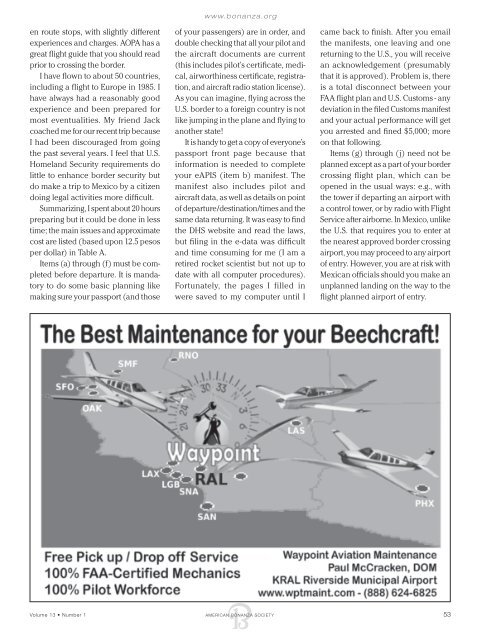Insurance Discount May Pay for Your BPPP Training - American ...
Insurance Discount May Pay for Your BPPP Training - American ...
Insurance Discount May Pay for Your BPPP Training - American ...
You also want an ePaper? Increase the reach of your titles
YUMPU automatically turns print PDFs into web optimized ePapers that Google loves.
en route stops, with slightly different<br />
experiences and charges. AOPA has a<br />
great flight guide that you should read<br />
prior to crossing the border.<br />
I have flown to about 50 countries,<br />
including a flight to Europe in 1985. I<br />
have always had a reasonably good<br />
experience and been prepared <strong>for</strong><br />
most eventualities. My friend Jack<br />
coached me <strong>for</strong> our recent trip because<br />
I had been discouraged from going<br />
the past several years. I feel that U.S.<br />
Homeland Security requirements do<br />
little to enhance border security but<br />
do make a trip to Mexico by a citizen<br />
doing legal activities more difficult.<br />
Summarizing, I spent about 20 hours<br />
preparing but it could be done in less<br />
time; the main issues and approximate<br />
cost are listed (based upon 12.5 pesos<br />
per dollar) in Table A.<br />
Items (a) through (f) must be completed<br />
be<strong>for</strong>e departure. It is mandatory<br />
to do some basic planning like<br />
making sure your passport (and those<br />
www.bonanza.org<br />
of your passengers) are in order, and<br />
double checking that all your pilot and<br />
the aircraft documents are current<br />
(this includes pilot’s certificate, medical,<br />
airworthiness certificate, registration,<br />
and aircraft radio station license).<br />
As you can imagine, flying across the<br />
U.S. border to a <strong>for</strong>eign country is not<br />
like jumping in the plane and flying to<br />
another state!<br />
It is handy to get a copy of everyone’s<br />
passport front page because that<br />
in<strong>for</strong>mation is needed to complete<br />
your eAPIS (item b) manifest. The<br />
manifest also includes pilot and<br />
aircraft data, as well as details on point<br />
of departure/destination/times and the<br />
same data returning. It was easy to find<br />
the DHS website and read the laws,<br />
but filing in the e-data was difficult<br />
and time consuming <strong>for</strong> me (I am a<br />
retired rocket scientist but not up to<br />
date with all computer procedures).<br />
Fortunately, the pages I filled in<br />
were saved to my computer until I<br />
came back to finish. After you email<br />
the manifests, one leaving and one<br />
returning to the U.S., you will receive<br />
an acknowledgement (presumably<br />
that it is approved). Problem is, there<br />
is a total disconnect between your<br />
FAA flight plan and U.S. Customs - any<br />
deviation in the filed Customs manifest<br />
and your actual per<strong>for</strong>mance will get<br />
you arrested and fined $5,000; more<br />
on that following.<br />
Items (g) through (j) need not be<br />
planned except as a part of your border<br />
crossing flight plan, which can be<br />
opened in the usual ways: e.g., with<br />
the tower if departing an airport with<br />
a control tower, or by radio with Flight<br />
Service after airborne. In Mexico, unlike<br />
the U.S. that requires you to enter at<br />
the nearest approved border crossing<br />
airport, you may proceed to any airport<br />
of entry. However, you are at risk with<br />
Mexican officials should you make an<br />
unplanned landing on the way to the<br />
flight planned airport of entry.<br />
Volume 13 • Number 1 AMERICAN BONANZA SOCIETY 53

















